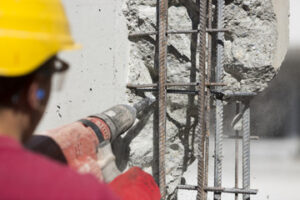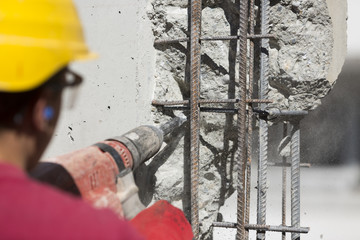Concrete surfaces outside the home can be damaged by weathering and heavy traffic. It is important that any damage be addressed promptly to prevent the problem from worsening and resulting in costly replacement projects.
Rather than replacing concrete, repairs may be a more affordable option to keep your outdoor spaces looking good. Read on Concrete Repair Bismarck for more details.
As with a visit to the dentist, proper preparation is key for an effective concrete repair. It’s the first step to achieving a beautiful and long-lasting result. For concrete repair, this involves cleaning the substrate and preparing the surface for application of the chosen concrete repair product.
Concrete is a highly porous material that can easily be penetrated by moisture and contaminants. This is why it’s important to regularly clean concrete surfaces and apply protective sealants. The proper use of these products helps prevent damage from occurring to the surface in the future.
Prior to starting a concrete repair project, the contractor should carefully assess the structure and the specific area in need of attention. This will help determine whether the project should be repaired or replaced. It will also help determine if the repair is effective or if the structure requires additional reinforcement. For example, if there are cracks that have not been properly addressed, it may be better to replace the affected areas rather than attempt a repair.
In some cases, it is a good idea to use a corrosion-inhibiting concrete product for the repair. This is especially true when the structure will be exposed to chloride-containing deicing salts, hydrofluoric acid, or petroleum products. These chemicals can degrade the concrete and weaken its structural integrity.
The concrete repair process should begin by sawing around the damaged area to delineate a work zone. This helps prevent the product from being pushed into secondary cracks or weak zones that aren’t visible to the naked eye.
Following this, the substrate should be cleaned thoroughly to remove any dirt, dust, or oils. This can be done with a variety of physical methods, such as pressure washing or sandblasting. Cleaning reinforcing steel is particularly important; rust can weaken the concrete and compromise its strength and durability. If the concrete is very heavily damaged, it may be necessary to install supplemental support structures.
The substrate should then be saturated with potable water to ensure that it is well saturated before applying the desired concrete repair product. This helps the product adhere to the existing concrete and reduces the chance that the repair will fail due to moisture vapor transport. It is also important to allow for adequate curing time; rushing the process can lead to failure of the repairs.
Repair Materials
Concrete repair materials are the products used to restore and protect concrete structures. They are essential for repairing structural damage, cracks, spalling, delamination, and other surface imperfections. Different types of damage require different types of repair materials. The best repair materials are tested and proven to be durable, cost-effective, and easy to use. They should also be compatible with the damaged concrete structure.
The most important factor in choosing the correct repair material is its strength. The concrete repair product should have a minimum compressive strength of 3000psi and a minimum tensile strength of 2500psi. It should also have good early mechanical properties and a short setting time. It is also important to consider the effects of shrinkage when selecting the concrete repair material. The permeability of the repair material should be low to prevent the penetration of aggressive chemicals such as water, oxygen, industrial gases and vapours, which can lead to corrosion of embedded reinforcement.
Other factors that need to be considered when selecting the repair material are its chemical properties, coefficient of thermal expansion, permeability and modulus of elasticity. The chemical properties of the repair material should be compatible with those of the existing concrete, especially if it is to be used in highly chloride-rich environments or exposed to strong sunlight for long periods. The coefficient of thermal expansion must be similar to that of the existing concrete to ensure that undue stresses are not transferred to the bond interface or the structure.
The permeability of the repair material should also be low to prevent the penetration of aggressive chemicals, such as water, oxygen and industrial gases and vapours, which can cause corrosion of reinforcement. The permeability of the repair material can be adjusted by using additives to increase the porosity, or by applying a sealer to the surface after application.
It is also necessary to select a concrete repair material that has a low drying shrinkage and a pH close to 12. The modulus of elasticity of the repair material should be similar to that of the existing concrete. This will help to reduce the tensile stresses induced by restrained drying shrinkage and thereby improve the durability of the repaired concrete.
Tools
If you’re an avid DIYer, or even just looking to save money on costly concrete repair services, you can learn to do the work yourself with the right tools. Whether you’re patching or resurfacing, there are seven essential tools that every concrete repairer should have in their toolbox.
The first step to a successful repair is proper surface preparation. This includes sweeping and pressure washing the area to remove any dirt, dust or debris that can act as bond breakers. It’s also important to bring the area up to saturated surface dry (SSD) condition to ensure a good bond between the existing and repair materials.
Once the surface is prepared, you’re ready to apply your chosen concrete repair product. Many of the products available are easy to use and pre-dosed for in-bag mixing. This eliminates the need for measuring and weighing components, making them easy to handle. Top ’N Bond, for example, can be applied with a margin trowel, rolled, rodded to eliminate air bubbles, and smoothed using a concrete trowel or float. Once it’s been smoothed, a metal finishing trowel can be used to burnish the surface for an attractive, long-lasting finish.
Another useful tool for repairing damaged concrete is a multisurface grinder like the Onfloor 16. This tool helps to create a smooth and consistent mixture when using any type of patching or overlay product.
A chisel and hammer can be used to undercut loose concrete in larger cracks or holes, which creates a clean and stable edge that will anchor the repair material more securely. Protective equipment, including a dust mask and gloves, should be worn during this phase to prevent inhaling concrete dust and other harmful materials.
Once your concrete has been repaired and allowed to cure, you can seal it with a waterproof or weatherproof concrete coating. This will help to preserve your repaired concrete surfaces, prolonging their life and minimizing the need for future repairs. It’s important to regularly assess the condition of your concrete surfaces and address any damage as soon as it appears. This will minimize the need for future repairs and reduce costly downtime due to damage or poor maintenance.
Safety
Concrete repair should always be done with safety in mind, regardless of the damage or size of the project. Wearing the appropriate protective gear, taking all necessary precautions and following any additional safety instructions is the best way to protect yourself when working with concrete. Taking this extra step will help to ensure the success of any concrete repair project.
To prevent future damage, it is also important to take regular measures to keep surfaces clean and protected. This includes regularly cleaning and applying a concrete sealant to prevent the absorption of moisture into the concrete surface, which can lead to cracks and other damage. In addition, it is important to address small issues as they appear. This can help to minimize the risk of more costly problems in the future and extend the lifespan of concrete surfaces.
In some cases, it may be necessary to hire a professional concrete repair company for severe or complex projects. Concrete repair companies can provide the expertise and experience necessary to get your project finished quickly and effectively. They can also offer advice and recommendations on how to best fix the problem, saving you time and money in the long run.
During the concrete repair process, it is crucial to understand the underlying cause of the damage. This will help you choose the right repair method and materials. For example, if the damage is caused by corrosion, it can be repaired with chemical treatments that are designed to prevent further deterioration.
The adhesion of new concrete to existing concrete is a significant factor in the durability of any concrete repair. Skipping surface preparation or using the wrong products can lead to poor adhesion and recurring problems. It is also important to allow the repair to cure properly. Rushing the curing process can weaken the repair and make it more susceptible to damage in the future.
Concrete damage poses a serious threat to the safety of pedestrians, motorists and occupants of buildings. Cracks and sunken areas can create tripping hazards that can lead to injuries. In addition, the structural integrity of buildings can be compromised if not addressed in a timely manner.


